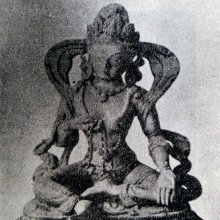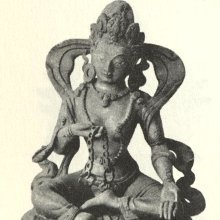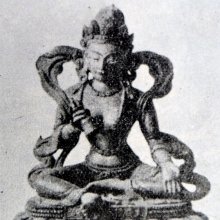Nirukti: 19 definitions
Introduction:
Nirukti means something in Buddhism, Pali, Hinduism, Sanskrit, Marathi, Hindi. If you want to know the exact meaning, history, etymology or English translation of this term then check out the descriptions on this page. Add your comment or reference to a book if you want to contribute to this summary article.
Images (photo gallery)
In Hinduism
Nyaya (school of philosophy)
Source: Shodhganga: A study of Nyāya-vaiśeṣika categoriesNirukti (निरुक्ति) or Paṭṭābhirāmaṭippaṇī is a commentary on the Tarkasaṃgraha which is ascribed to Paṭṭābhirāma or Mādhavapadābhirāma.—The Tarkasaṃgraha of Annaṃbhaṭṭa is a Sanskrit treatise dealing with the ancient Indian system of logic and reasoning. It’s language is easily understandable and is meant primarily to unlock the doors of the twin-darśana of Nyāya-Vaiśeṣika. There are about twenty five commentaries [viz., the Nirukti] both traditional and modern on this treatise which undoubtedly establishes the importance of Tarkasaṃgraha.
Nirukti (निरुक्ति) is also a commentary on the Tarkasaṃgraha ascribed to Jagannāthaśastri.

Nyaya (न्याय, nyaya) refers to a school of Hindu philosophy (astika), drawing its subject-matter from the Upanishads. The Nyaya philosophy is known for its theories on logic, methodology and epistemology, however, it is closely related with Vaisheshika in terms of metaphysics.
In Buddhism
Tibetan Buddhism (Vajrayana or tantric Buddhism)
Source: archive.org: The Indian Buddhist IconographyNirukti (निरुक्ति, “etymology”) or Niruktipratisaṃvit refers to one of four Pratisaṃvit Goddesses, as commonly depicted in Buddhist Iconography, and mentioned in the 11th-century Niṣpannayogāvalī of Mahāpaṇḍita Abhayākara.—Her Colour is red; her Symbol is the chain; she has two arms.
Nirukti is described in the Niṣpannayogāvalī (dharmadhātuvāgīśvara-maṇḍala) as follows:—
“In the West there is Nirkuti-Pratisaṃvit of red colour, holding in her two hands the chain from which a lotus is suspended”.
[A statuette of this obscure deity is found in the Chinese collection of Peiping.]

Tibetan Buddhism includes schools such as Nyingma, Kadampa, Kagyu and Gelug. Their primary canon of literature is divided in two broad categories: The Kangyur, which consists of Buddha’s words, and the Tengyur, which includes commentaries from various sources. Esotericism and tantra techniques (vajrayāna) are collected indepently.
Mahayana (major branch of Buddhism)
Source: academia.edu: A Study and Translation of the GaganagañjaparipṛcchāNirukti (निरुक्ति) refers to “interpretation”, according to the Gaganagañjaparipṛcchā: the eighth chapter of the Mahāsaṃnipāta (a collection of Mahāyāna Buddhist Sūtras).—Accordingly as The Lord said: “O Śāriputra, in the buddha-field of the Tathāgata Ekaratnavyūha, there is a Bodhisattva, the great being Gaganagañja who is resplendent by the splendor of merit (puṇya-tejas), [...] who is purified in the realm of five eyes adorned with the [divine] sight (cakṣus), is endowed with the essence of understanding of all meaning with sound as adorned with the [divine] hearing, teaches the imperishable knowledge of the meaning, dharmas, interpretation (nirukti), and eloquence as adorned with special knowledge (pratisaṃvid), [...]”.

Mahayana (महायान, mahāyāna) is a major branch of Buddhism focusing on the path of a Bodhisattva (spiritual aspirants/ enlightened beings). Extant literature is vast and primarely composed in the Sanskrit language. There are many sūtras of which some of the earliest are the various Prajñāpāramitā sūtras.
General definition (in Buddhism)
Source: Wisdom Library: Dharma-samgrahaNirukti (निरुक्ति, “language”) or Niruktipratisaṃvid refers to one of the “four analytical knowledges” (pratisaṃvid) as defined in the Dharma-saṃgraha (section 51). The Dharma-samgraha (Dharmasangraha) is an extensive glossary of Buddhist technical terms in Sanskrit (e.g., nirukti). The work is attributed to Nagarjuna who lived around the 2nd century A.D.
Languages of India and abroad
Marathi-English dictionary
Source: DDSA: The Molesworth Marathi and English Dictionarynirukti (निरुक्ति).—f S Defining, describing; definition or description.
Source: DDSA: The Aryabhusan school dictionary, Marathi-Englishnirukti (निरुक्ति).—f Describing; definition.
Marathi is an Indo-European language having over 70 million native speakers people in (predominantly) Maharashtra India. Marathi, like many other Indo-Aryan languages, evolved from early forms of Prakrit, which itself is a subset of Sanskrit, one of the most ancient languages of the world.
Sanskrit dictionary
Source: DDSA: The practical Sanskrit-English dictionaryNirukti (निरुक्ति).—f.
1) Derivation, etymological interpretation of words; जरत्कारुनिरुक्तिं त्वं यथावद्वक्तुमर्हसि (jaratkāruniruktiṃ tvaṃ yathāvadvaktumarhasi) Mahābhārata (Bombay) 1.4.2.
2) (In Rhet.) An artificial explanation of the derivation of a word; thus defined:-निरुक्तिर्योगतो नाम्नामन्यार्थत्व- प्रकल्पनम् । ईदृशैश्चरितैर्जाने सत्यं दोषाकरो भवान् (niruktiryogato nāmnāmanyārthatva- prakalpanam | īdṛśaiścaritairjāne satyaṃ doṣākaro bhavān) || Chandr.5.168 (where doṣākaraḥ is equal to doṣāṇāmākaraḥ).
3) (In drama.) communication of an event that has taken place.
4) Name of Yāska's commentary on the Nighaṇṭus.
Derivable forms: niruktiḥ (निरुक्तिः).
Source: Cologne Digital Sanskrit Dictionaries: Edgerton Buddhist Hybrid Sanskrit DictionaryNirukti (निरुक्ति).—f. = Sanskrit id., Pali nirutti, explanation, not necessarily etymological, of the meaning of a word or text; one of the four pratisaṃvid(ā), q.v.; other cases: nānābhinirhāra-nirdeśa-vividha-hetu-kāraṇa-nidarśanāram- baṇa-nirukty-upāyakauśalyair Saddharmapuṇḍarīka 41.2, 12; 71.7; nānā- nirukti-nirdeśābhilāpanirdeśanair 39.11; nānāniruktīhi ca kāraṇehi 45.5 (verse), by various explanations and reasons; nirukti dharmāṇa bahū prajānati 238.1 (verse), he knows many explanations of the dharmas; nirukti-rutebhir Gaṇḍavyūha 231.3 (verse).
Source: Cologne Digital Sanskrit Dictionaries: Shabda-Sagara Sanskrit-English DictionaryNirukti (निरुक्ति).—f.
(-ktiḥ) The Vedanga or portion of the scriptural science, which explains obscure and obsolete terms. 2. Explanation of words. 3. An artificial explanation of the derivation of a word; (In rhetoric). see the last. E. nir, and ukti saying, or nir + vaca-ktin .
Source: Cologne Digital Sanskrit Dictionaries: Benfey Sanskrit-English DictionaryNirukti (निरुक्ति).—i. e. nis-vac + tī, f. 1. Interpretation, [Bhāgavata-Purāṇa, (ed. Burnouf.)] 5, 11, 3. 2. Etymological explanation, Mahābhārata 1, 1656.
Source: Cologne Digital Sanskrit Dictionaries: Cappeller Sanskrit-English DictionaryNirukti (निरुक्ति).—[feminine] = [preceding] [neuter]
Source: Cologne Digital Sanskrit Dictionaries: Aufrecht Catalogus CatalogorumNirukti (निरुक्ति) as mentioned in Aufrecht’s Catalogus Catalogorum:—a
—[commentary] on the Tarkasaṃgraha by Jagannātha Śāstrin. Rice. 112.
—by Paṭṭābhirāma.
1) Nirukti (निरुक्ति):—[=nir-ukti] [from nir-ukta] f. etymological interpretation of a word, [Mahābhārata; Bhāgavata-purāṇa]
2) [v.s. ...] (in [rhetoric]) an artificial explanation or derivation of a word, [Kuvalayānanda]
3) [v.s. ...] (in [dramatic language]) communication of an event that has taken place, [Sāhitya-darpaṇa]
4) [v.s. ...] Name of Yāska’s [commentator or commentary] on the Nighaṇṭus
5) [v.s. ...] of a [commentator or commentary] on the Tarka-saṃgraha etc.
Source: Cologne Digital Sanskrit Dictionaries: Yates Sanskrit-English DictionaryNirukti (निरुक्ति):—[niru+kti] (ktiḥ) 2. f. Idem.
Source: DDSA: Paia-sadda-mahannavo; a comprehensive Prakrit Hindi dictionary (S)Nirukti (निरुक्ति) in the Sanskrit language is related to the Prakrit word: Ṇirutti.
[Sanskrit to German]
Sanskrit, also spelled संस्कृतम् (saṃskṛtam), is an ancient language of India commonly seen as the grandmother of the Indo-European language family (even English!). Closely allied with Prakrit and Pali, Sanskrit is more exhaustive in both grammar and terms and has the most extensive collection of literature in the world, greatly surpassing its sister-languages Greek and Latin.
Hindi dictionary
Source: DDSA: A practical Hindi-English dictionaryNirukti (निरुक्ति):—(nf) etymology; etymology or exposition of Vedic words, etymological explanation or exposition (of words).
...
Kannada-English dictionary
Source: Alar: Kannada-English corpusNirukti (ನಿರುಕ್ತಿ):—
1) [noun] = ನಿರುಕ್ತ [nirukta]2 - 2 & 3.
2) [noun] that which is stated; a statement; a declaration.
3) [noun] an explanation of the meaning of a statement, literary work, etc.; an elucidation.
4) [noun] an artificial explanation or derivation of a word.
Kannada is a Dravidian language (as opposed to the Indo-European language family) mainly spoken in the southwestern region of India.
See also (Relevant definitions)
Starts with: Niruktikara, Niruktikhanda, Niruktilakshana, Niruktiniyatapravesha, Niruktiprakasha, Niruktipratibhana, Niruktipratisamvid, Niruktisu.
Ends with: Aksharanirukti, Angatvanirukti, Avachedakatvanirukti, Avimuktanirukti, Mithyatvanirukti, Nishcayatvanirukti, Nishchayatvanirukti, Purvapakshanirukti, Sadharanasadharananirukti, Samanyanirukti, Savyabhicaranirukti, Savyabhicarasamanyanirukti, Shankatvanirukti, Tarkasamgrahavakyarthanirukti, Vakpatavanirukti, Visheshanirukti, Vritticandrapradipikanirukti.
Full-text (+32): Pratisamvid, Nirutti, Niryukti, Niruktiprakasha, Niruktilakshana, Niruktikhanda, Nairukta, Niruktipratisamvid, Vedanga, Samanyaniruktigranthartha, Samanyaniruktipattra, Samanyaniruktiprathamalakshana, Samanyaniruktidvitiyatakshana, Samanyaniruktitika, Samanyaniruktivivecana, Samanyaniruktivyakhya, Samanyaniruktikroda, Samanyaniruktilakshana, Samanyaniruktigrantharahasya, Samanyaniruktididhititika.
Relevant text
Search found 16 books and stories containing Nirukti, Nir-ukti; (plurals include: Niruktis, uktis). You can also click to the full overview containing English textual excerpts. Below are direct links for the most relevant articles:
The Indian Buddhist Iconography (by Benoytosh Bhattachacharyya)
Figure 224 - Four Pratisaṃvits: Nirukti-Pratisaṃvit
Maha Prajnaparamita Sastra (by Gelongma Karma Migme Chödrön)
I. The pratisaṃvids according to the Abhidharma < [Part 3 - The four unhindered knowledges]
Preliminary note on the four unhindered knowledges (pratisaṃvid) < [Part 3 - The four unhindered knowledges]
II. The pratisaṃvids according to the Mahāyāna < [Part 3 - The four unhindered knowledges]
Nyaya-Vaisheshika categories (Study) (by Diptimani Goswami)
The Commentaries on Tarkasaṃgraha < [Chapter 1 - Introduction]
The validity of Anumana (inference) in Nyaya system (by Babu C. D)
Chapter 4.3.6 - Navya Nyaya (f): Philosophers after Gangesha
Chapter 4.2.5 - The Prakaranas (e): Tarkasamgraha by Annam Bhatta
Jainism in Odisha (Orissa) (by Ashis Ranjan Sahoo)
Book Reviews < [January – March, 2000]
Is Music a Vidya or a Kala < [Jan - Feb 1939]
Reviews < [April – June, 1988]
Related products



